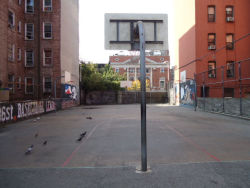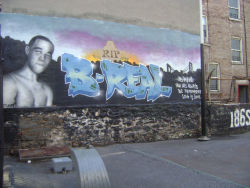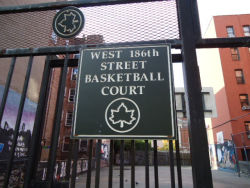West 186th Street Basketball Court
West 186th Street Basketball Court
Once the site of useless rubble, this small urban lot has been transformed into much needed recreational space.
The West 186th Street Basketball Court lies between Audubon and Saint Nicholas Avenues in Washington Heights, a neighborhood bounded by Dyckman Street, the Harlem River, 155th Street, and the Hudson River. During the American Revolution (1775-1783), this area housed several colonial forts, including the neighborhood’s namesake, Fort Washington. In 1889, the Washington Bridge was completed over the Harlem River, linking Manhattan and the Bronx. The area was still largely rural when the Broadway subway line extended through the southern portion of the neighborhood in 1904 and subsequently extended northward during 1906.
The transportation improvement led to the exponential growth of the area. Several institutions were built at that time, including the Columbia-Presbyterian Medical Center, Audubon Terrace, Yeshiva University, and the Polo Grounds stadium. During the 1980s, Washington Heights attracted the largest number of immigrants of any neighborhood in New York City, and by 1990, the neighborhood’s Dominican community was the largest in the United States. The following year, residents elected Guillermo Linares to the City Council, making him the first individual of Dominican ancestry to hold political office in New York.
An apartment building once stood on this site. Demolished in the 1970s, it left behind a single empty lot in a heavily urbanized area. The City of New York acquired the abandoned property in 1978, but it remained undeveloped until the 1990s, when the Association of Progressive Dominicans (ACDP) received permission from the City to build a basketball court here. The ACDP maintained the court during the 1990s, and in 1997, the property was assigned to Parks by the Department of Citywide Administrative Services. The City installed fencing, lighting, and new basketball hoops that same year. In 1998, Bio Nicer painted the large mural seen on the western wall of the court in memory of Rudy Frias, a local resident who died in an alcohol-related automobile accident in 1998. The painting contains the names of many local residents who have played in the basketball games held here in the warmer months of the year.
Check out your park's Vital Signs
Clean & Safe
Green & Resilient
Empowered & Engaged Users
Share your feedback or learn more about how this park is part of a
Vital Park System



